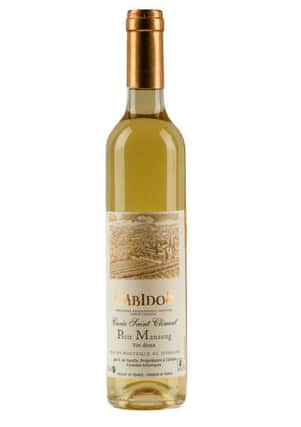Drink: The twin virtues of the French grapes winemerchants and sommeliers love


Two white grapes from south-west France, petit manseng and gros manseng, are fast becoming sommelier and winemerchant favourites, thanks to their enticing aromas and electrifying acidity.
Both mansengs originate from the Pyrénees area of Bearn and Jurançon – mentioned in records since 1562 – but the two were not distinguished as individual grapes, petit and gros, until the 18th century. Due to the phylloxera crisis, the mansengs almost became extinct – and by the 1980s there were few hectares left, even in France. Now the resurgence of interest by Pyrénees growers has seen plantings increase to more than 4,000 hectares.
Advertisement
Hide AdAdvertisement
Hide AdThe classier and higher quality grape of the two is petit manseng. Named after its small thick-skinned berries, it is a low yielder of intense, sugar-rich grapes with little juice and a lot of natural acidity which makes delectable sweet wines. It is a tricky grape to grow, but has an increasing following now across south-west France and even in the east in Languedoc and the Rhône Valley.
Larger berried gros manseng is easier to plant and offers higher yields, which explains why there are 3,000 hectares of it compared to petit’s 1,000ha.
The big berried gros does not have the richness and character of petit, but when used for dry unoaked wines it has attractive apricot and quince hints and is often blended with the richer petit. When planted on clay it tends to have more depth. Gros is not only found in Bearn and Jurançon, but also in nearby appellations Pacherenc du Vic Bilh and Côtes de Gascony, where it is also blended with colombard (for example, as in Tesco’s Finest Côtes de Gascogne white, £6).
Thanks to the recent surge in interest, winegrowers worldwide from Japan to New Zealand are now planting manseng. Of the two, petit manseng is preferred by growers abroad.
You can now find small plantings in Portugal, South Africa, Victoria in Australia, Marlborough in New Zealand and even in Virginia and Georgia, as petit manseng’s high acidity suits the warm summers there.
Dry white
Jurançon SEC 2014 Domaine Laguihou
Made from equal percentages of both mansengs. If you like your white dry, taut, pure and intense, with vivid acidity, you will love the dry whites of Jurançon. Deliciously juicy and peachy with a tangy freshness. Serve as aperitif or with crab or scallops.
£14.99, Cornelius Wines, Edinburgh
Côtes De St Mont Les Vignes Retrouvées 2014
St Mont region south-west of Gascony uses similar grapes to nearby Jurançon in a slightly fatter style. So while you don’t get the whistle sharp purity of Jurançon, you get a lovely floral, citric, fruity unoaked dry white. Serve with rich textured seafood dishes.
£7.95, The Wine Society, www.thewinesociety.com
Petit Manseng 2015 Churton Vineyards
Fascinating to taste New Zealand’s one and only petit manseng. Made by an enterprising English couple, Sam and Mandy Weaver, who named their New Zealand winery after Sam’s Shropshire birthplace. Fabulous apricot and honeyed aroma, beautiful depth of flavour with enticing sweetness but not at all cloying, thanks to the wonderful natural, vibrant acid and dry finish. Production of this wine is still minute with just 0.5 hectares planted, hence the price.
£38, half litre, Berry Bros & Rudd, www.bbr.com
Sweet dessert white
Jurançon La Magendia 2012 Domaine Lapeyre
Advertisement
Hide AdAdvertisement
Hide AdWild flowers, pineapple and passionfruit combine with a superb acidity that flows like an electric current across this honeyed sweetness. This deliciously gentle petit manseng-based dessert wine is made by the wine ‘poet’ of the region Jean Bernard Larrieu. Serve with foie gras or with fruit salad or tarte Tatin.
£12.99, hf bt, Les Caves de Pyrene, www.lescaves.co.uk; £14.99, Selfridges; www.smilinggrape.com
Cabidos Vin Doux Cuvée Saint Clément Petit Manseng 2012
Beautiful Chateau Cabidos has a Thai winemaker making superb value sweet wines from their Pyrenees-based chateau north of Pau and Bearn. This enchanting sweet wine is made from 100 per cent petit manseng grapes by the ancient ‘passerillage’ method, where stems are twisted whilst grapes are still on the vine, dehydrating the grapes and increasing sweet concentration. The late picked grapes are then fermented and matured to make an enchantingly fresh but sweet honeyed dessert wine. Serve with crème brûlée, apple crumble or crêpes Suzette.
£9.50 for 50 cl bt, The Wine Society, www.thewinesociety.com
Symphonie De November 2014 Domaine Cauhape
Named after the month of harvest, this delicate sweet wine has exotic fruit aromas, ripe citric flavours, and a mouthwatering juiciness thanks to the vibrant natural acidity. Made by local legend and owner of Domaine Cauhape, Henri Romanteau in Jurançon. A fine match with blue cheese or lemon cheesecake.
£12 hf bt, Fine Wine Co, Musselburgh
Join Rose’s wine tastings in Edinburgh, Glasgow & St Andrews, www.rosemurray brown.com